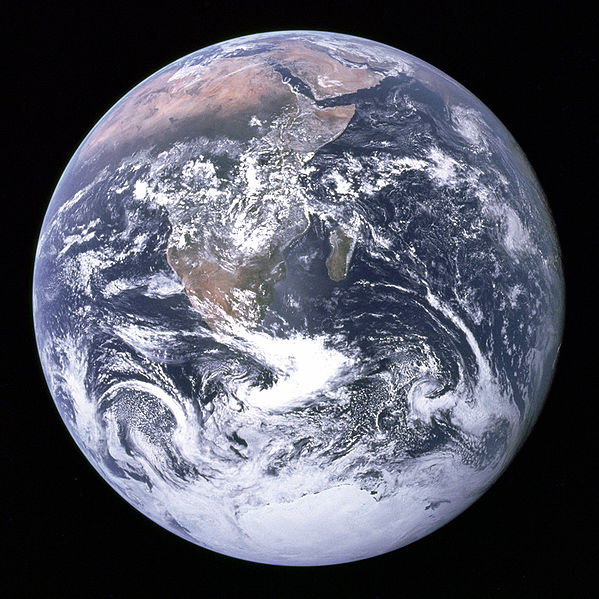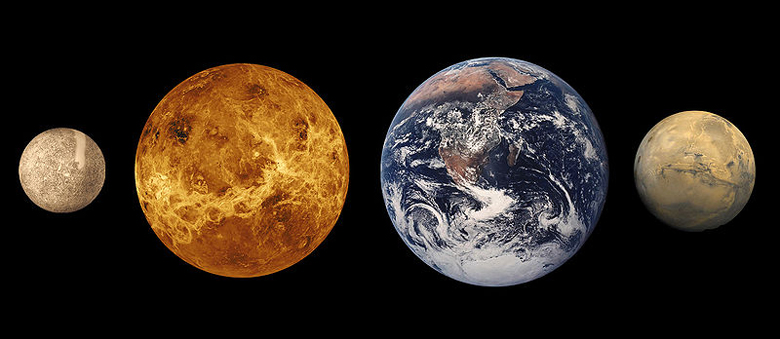 |
The
Earth |
Our
Own Planet |
Earth
is the third planet from the Sun. Earth is the largest of the terrestrial planets
in the Solar System in diameter, mass and density. It is also referred to as the
World and Terra. Home to millions of species, including humans, Earth is the only place in the universe where life is known to exist. The planet formed 4.54 billion years ago, and life appeared on its surface within a billion years. Since then, Earth's biosphere has significantly altered the atmosphere and other abiotic conditions on the planet, enabling the proliferation of aerobic organisms as well as the formation of the ozone layer which, together with Earth's magnetic field, blocks harmful radiation, permitting life on land. The physical properties of the Earth, as well as its geological history and orbit, allowed life to persist during this period. The world is expected to continue supporting life for another 1.5 billion years, after which the rising luminosity of the Sun will eliminate the biosphere. Earth's outer surface is divided into several rigid segments, or tectonic plates, that gradually migrate across the surface over periods of many millions of years. About 71% of the surface is covered with salt-water oceans, the remainder consisting of continents and islands; liquid water, necessary for all known life, is not known to exist on any other planet's surface. Earth's interior remains active, with a thick layer of relatively solid mantle, a liquid outer core that generates a magnetic field, and a solid iron inner core. |
Earth interacts with other objects in outer space, including the Sun and the Moon. At present, Earth orbits the Sun once for every roughly 366.26 times it rotates about its axis. This length of time is a sidereal year, which is equal to 365.26 solar days. The Earth's axis of rotation is tilted 23.4° away from the perpendicular to its orbital plane, producing seasonal variations on the planet's surface with a period of one tropical year (365.24 solar days). Earth's only known natural satellite, the Moon, which began orbiting it about 4.53 billion years ago, provides ocean tides, stabilizes the axial tilt and gradually slows the planet's rotation. Between approximately 4.1 and 3.8 billion years ago, asteroid impacts during the Late Heavy Bombardment caused significant changes to the surface environment. Both the mineral resources of the planet, as well as the products of the biosphere, contribute resources that are used to support a global human population. The inhabitants are grouped into about 200 independent sovereign states, which interact through diplomacy, travel, trade and military action. Human cultures have developed many views of the planet, including personification as a deity, a belief in a flat Earth, and a modern perspective of the world as an integrated environment that requires stewardship. |
 |
The
famous "Blue Marble" photograph of Earth, taken from Apollo 17 |
| Chronology Scientists have been able to reconstruct detailed information about the planet's past. The earliest dated solar system material is dated to 4.5672 ± 0.0006 billion years ago, and by 4.54 billion years ago (within an uncertainty of 1%) the Earth and the other planets in the Solar System formed out of the solar nebula—a disk-shaped mass of dust and gas left over from the formation of the Sun. This assembly of the Earth through accretion was largely completed within 10–20 million years. Initially molten, the outer layer of the planet Earth cooled to form a solid crust when water began accumulating in the atmosphere. The Moon formed soon afterward, most likely as the result of a Mars-sized object (sometimes called Theia) with about 10% of the Earth's mass impacting the Earth in a glancing blow. Some of this object's mass would have merged with the Earth and a portion would have been ejected into space, but enough material would have been sent into orbit to form the Moon. Outgassing
and volcanic activity produced the primordial atmosphere. Condensing water vapor,
augmented by ice and liquid water delivered by asteroids and the larger proto-planets,
comets, and trans-Neptunian objects produced the oceans. Two major models have
been proposed for the rate of continental growth: steady growth to the present-day
and rapid growth early in Earth history. Current research shows that the second
option is most likely, with rapid initial growth of continental crust followed
by a long-term steady continental area. On time scales lasting hundreds of millions
of years, the surface continually reshaped itself as continents formed and broke
up. The continents migrated across the surface, occasionally combining to form
a supercontinent. Roughly 750 million years ago (mya), one of the earliest known
supercontinents, Rodinia, began to break apart. The continents later recombined
to form Pannotia, 600–540 mya, then finally Pangaea, which broke apart 180
mya. Since the 1960s, it has been hypothesized that severe glacial action between 750 and 580 mya, during the Neoproterozoic, covered much of the planet in a sheet of ice. This hypothesis has been termed "Snowball Earth", and is of particular interest because it preceded the Cambrian explosion, when multicellular life forms began to proliferate. Following the Cambrian explosion, about 535 mya, there have been five mass extinctions. The last extinction event was 65 mya, when a meteorite collision probably triggered the extinction of the (non-avian) dinosaurs and other large reptiles, but spared small animals such as mammals, which then resembled shrews. Over the past 65 million years, mammalian life has diversified, and several mya, an African ape-like animal gained the ability to stand upright. This enabled tool use and encouraged communication that provided the nutrition and stimulation needed for a larger brain. The development of agriculture, and then civilization, allowed humans to influence the Earth in a short time span as no other life form had,[39] affecting both the nature and quantity of other life forms. The present pattern of ice ages began about 40 mya and then intensified during the Pleistocene about 3 mya. The polar regions have since undergone repeated cycles of glaciation and thaw, repeating every 40–100,000 years. The last ice age ended 10,000 years ago. |
Terrestrial
planet size comparisons A terrestrial planet is a planet that is primarily composed of silicate rocks. The term is derived from the Latin word for Earth, "Terra", so an alternate definition would be that these are planets which are, in some notable fashion, "Earth-like". Terrestrial planets are substantially different from gas giants, which might not have solid surfaces and are composed mostly of some combination of hydrogen, helium, and water existing in various physical states. Terrestrial planets all have roughly the same structure: a central metallic core, mostly iron, with a surrounding silicate mantle. Terrestrial planets have canyons, craters, mountains, volcanoes and secondary atmospheres. |
 |